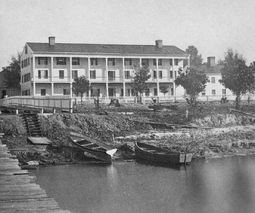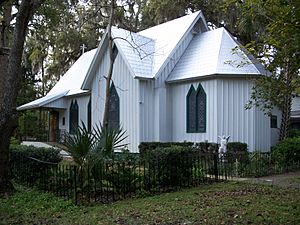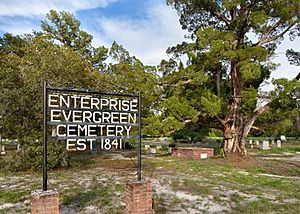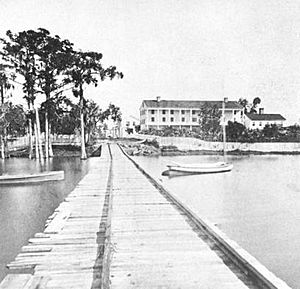Enterprise, Florida facts for kids
Quick facts for kids
Enterprise
Benson Springs
|
|
|---|---|
| Enterprise | |

Brock House in Enterprise, Florida - Circa 1875
|
|

Location in Volusia County and the state of Florida
|
|
| Country | United States |
| State | Florida |
| County | Volusia |
| Elevation | 20 ft (6 m) |
| Time zone | UTC-5 (EST) |
| • Summer (DST) | UTC-4 (EDT) |
| ZIP code(s) |
32725
|
| Area code(s) | 386 |
| GNIS feature ID | 282231 |
Enterprise is a small community in Volusia County, Florida. It's called an "unincorporated community" because it doesn't have its own city government. Instead, it's governed by Volusia County.
Enterprise is located on the northern shore of Lake Monroe. It is close to the cities of DeBary and Deltona. This area was once very important for boats traveling on the St. Johns River. Enterprise also used to be the main government center, or "county seat," for three different counties at various times.
In 2006, Volusia County decided that Enterprise is a special historic village. This means that any new buildings or changes must follow strict rules. These rules help keep the community's historic look and feel.
Contents
Exploring Enterprise's Past
Early Days and Native Peoples
In 1565, explorer Pedro Menéndez de Avilés traveled up the St. Johns River. He might have even reached Lake Monroe. At that time, the Mayaca Indians lived in this area. They lived in small villages and found their food from nature.
The Mayaca people ate snails, shellfish, turtles, deer, and alligators. They also gathered roots, nuts, and berries. The large "Enterprise midden" is a huge mound of shells. It grew over thousands of years from the Mayaca people's cooking and tool-making activities.
When Europeans arrived, the lives of Florida's native people changed. Diseases brought by Europeans caused many to get sick. There were also conflicts and forced labor. By the 1760s, many native cultures, including the Mayaca, had almost disappeared. Later, Seminole Indians from Alabama and Georgia moved into Florida.
The Nineteenth Century: Growth and Change
After the United States took over Florida in 1821, there were conflicts with the Seminole people. These were called the Seminole Wars. The U.S. government wanted to move the Seminole people to other lands. In 1835, the Seminole burned Palatka, a big port on the St. Johns River.
Because of these conflicts, the U.S. built Fort Kingsbury in 1838. This was a wooden fort built in Enterprise. It was meant to protect settlers.
In 1842, a law called the Armed Occupation Act was passed. It gave land to settlers who would clear and farm it. Cornelius Taylor was one of these settlers. In 1841, he and about 20 others started the settlement of "Enterprise."
Taylor built an inn on top of the shell midden. This inn welcomed visitors who arrived by steamboat. People also started planting orange groves. A gristmill (for grinding grain) and a sawmill were also built. The sawmill cut Southern live oak wood, which was used for warships.
In 1843, Enterprise became the county seat for "Mosquito County." This county was later renamed "Orange County." An illness, possibly smallpox, affected the community in 1842. Cornelius Taylor left Enterprise in 1847.
Jacob Brock and Steamboat Travel
In 1851, Jacob Brock bought land near the original settlement. He built a wharf (a place for boats to dock) and planned out streets. Brock was a steamboat captain. He brought many people to Enterprise who were looking for a healthy climate. They also came for the sulfur springs, which people believed could cure illnesses.
In 1854, Brock finished building The Brock House. This was a large hotel with rooms for over 50 guests. That same year, Volusia County was formed, and Enterprise became its county seat. Brock started the first regular steamboat service from Jacksonville to Enterprise.
The steamboat trip was about 206 miles (332 km) long. The Darlington steamboat would leave Jacksonville on Saturday morning. It would arrive in Palatka on Sunday. On Monday morning, it would leave Palatka and reach Enterprise by evening. Steamboat captains had to be careful. They watched for snakes falling from trees and alligators in the water.
The Civil War Era
During the Civil War, the St. Johns River became a dangerous place. In 1864, Union forces captured a Confederate steamboat called the Hattie Brock. It was named after Captain Brock's daughter. The boat was carrying cotton to help fund the Confederate cause.
The Union soldiers took the boat to Brock's wharf to load wood for fuel. From the hotel, Miss Brock was very upset about her boat being captured. The soldiers also took some people who were likely enslaved, and sugar from a nearby sugar refinery. They then destroyed the refinery.
Post-War Boom and Decline
After the Civil War, tourism in Florida grew. Enterprise became a popular place for vacations and hunting. Harriet Beecher Stowe, a famous writer, described the St. Johns River as "unearthly in its beauty."
The Brock House hotel was sold and improved in 1876. It became one of the most famous hotels in Florida. Important guests included Presidents Ulysses S. Grant and Grover Cleveland. Other famous people like General William Sherman and members of the Vanderbilt family also stayed there. Visitors came from England, France, and South America too. In 1877, Enterprise officially became a town.
Another important visitor was Frederick deBary. He was a wealthy importer of French wines. After staying at The Brock House in 1870, he bought land to the west. In 1871, he built DeBary Hall, a large mansion and hunting lodge. DeBary also planted orange groves and pecan trees.
In 1876, deBary started a steamship company to carry mail. He also helped build the beautiful Gothic Revival All Saints Episcopal Church. It was finished in 1883 and is now on the National Register of Historic Places.
In 1885, a railroad line connected Titusville to Enterprise. But in 1888, an epidemic of yellow fever hit Florida. The number of people living in Enterprise decreased. DeLand then became the new county seat.
The severe freezes of 1894 and 1895 destroyed many citrus groves in Florida, including deBary's. In 1895, Enterprise voted to stop being an incorporated town. The unique shell midden, which was once on the town's seal, eventually disappeared. Its shells were used to pave streets and sidewalks.
The Twentieth and Twenty-First Centuries
In 1924, the George E. Turner Power Plant was built near Lake Monroe. Around this time, the town's name was changed to "Benson Springs." This change was requested by the Benson Springs Hotel. However, the name "Benson Springs" was not popular. In 1937, the town's name changed back to "Enterprise." The old hotel was torn down that same year to make room for the Florida United Methodist Children's Home.
The railroad branch was closed in the 1950s, and its tracks were removed in the 1970s. The George E. Turner Power Plant was taken apart between 2007 and 2008.
Today, Enterprise is working to keep its unique identity. It wants to avoid being absorbed by the larger city of Deltona. In 2000, the Enterprise Preservation Society (EPS) was created. This group works to protect Enterprise's rural feel and history. They also try to prevent Deltona from taking over parts of Enterprise.
The EPS helped Enterprise get special protections from Volusia County. These include being named a "Community of Special Interest." This means there are extra rules for building and landscaping. The "Enterprise Historic District" was also created. This area includes several blocks of the historic downtown.
In 2003, an old school building, Enterprise Elementary School Building #8, was going to be torn down. Instead, it was given to the EPS. In 2007, the building was moved to a new location. After many years of hard work by volunteers, it reopened in October 2014. It is now the Enterprise Heritage Center & Museum.




